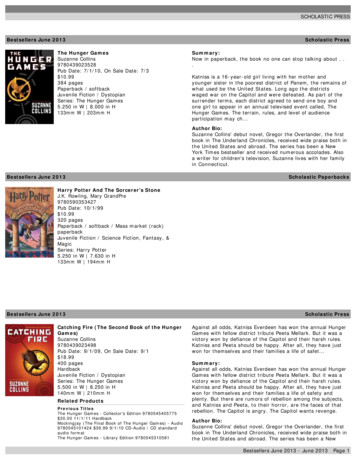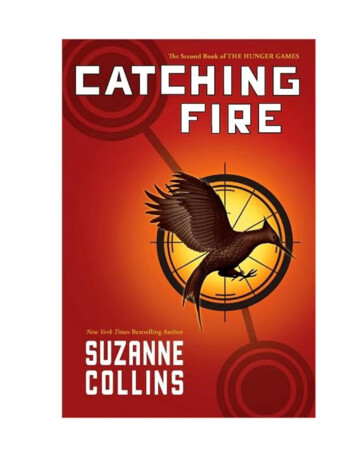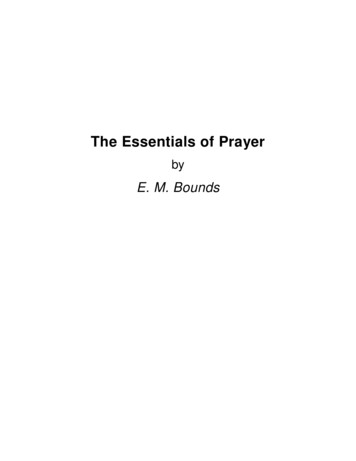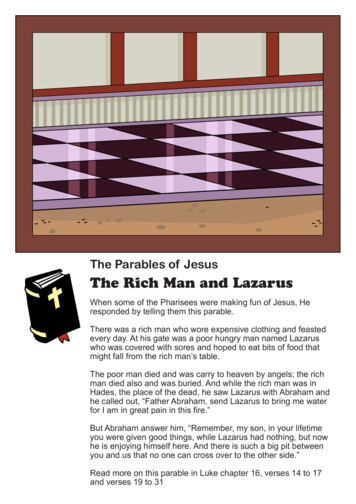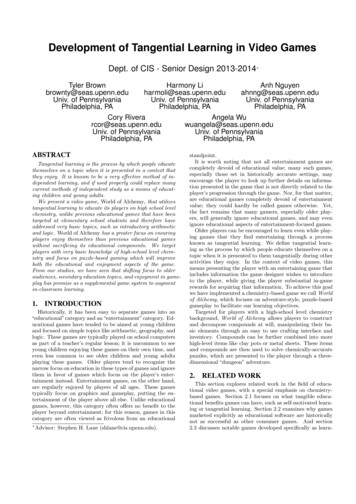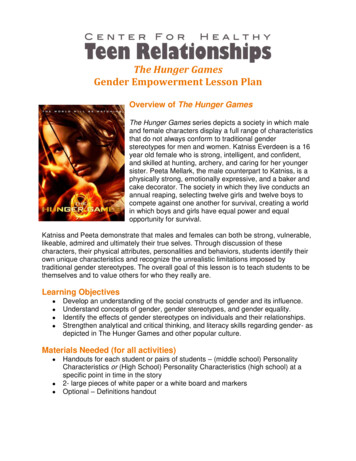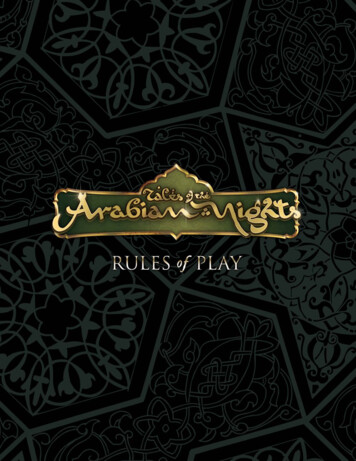
Transcription
TABLE OF– CONTENTSWinning the Game . 3Play Overview . 3Components . 3Set Up . 4Quest Cards . 5Game Sequence Overview . 6The Book of Tales . 6The Movement Phase . 7Places of Power . 7The Encounter Phase . 8The Encounter Cards . 8Character Encounter Cards and Terrain Encounter Cards . 8Terrain Encounter Card . 8City Encounter Cards . 9Encounters in Places of Power . 9Resolving Encounters . 9Discover Who or What You Have Encountered . 9Encounter Charts . 10Choose Your Reaction . 10Determine Your Destiny. 10Read the Result Paragraph . 1 1Skills . 12Master Skills . 13Losing Skills . 13How to Resolve an Encounter . 13Statuses . 14Effects of Statuses . 14Wealth . 14Selling Treasures . 14Death . 14Game End . 15Answers to Common Questions . 15Movement . 15Negative Destiny and Story Points . 15Optional Rules . 15Shorter Games . 15There are more ways to play! . 15A Note to Western Readers . 16Credits . 17Biographies . 18In Tales of the Arabian Nights, you are the hero or heroine in a story of adventure andwonder just like those told by Scheherazade to her spellbound sultan! You will travel theland seeking your own destiny and fortune. You will learn stories and gain wisdom to sharewith others. Will you be the first to fulfill your destiny? The next Tale is yours to tell!There is, of course, a winner in Tales of the Arabian Nights, but the true joy of the game isenjoying the unfolding and telling of a great story!WINNING THE GAMEIf you are the first player to collect your own chosen goal of Story and Destiny Points andreturn safely to Baghdad, you win the game!PLAY OVERVIEWTales of the Arabian Nights is a paragraph-based board game. What does that mean? During thegame you and the other players will encounter all sorts of strange events, beings, and creatures.Each encounter will refer to a Reaction Matrix, which will offer you several choices of how torespond to the encounter. Your choice will guide you to a paragraph in the Book of Tales, whichwill reveal the outcome of your encounter. The skills and statuses of your character may affectyour results, for good or ill!COMPONENTSEach copy of Tales of the Arabian Nights includes:One mounted game mapThree sheets of cardboard markersOne rules booklet (you’re holding it)One Book of Tales (don’t read this yet!)A Reaction Matrix bookletSix Player ReferencesSix Character stand-ups plus stands30 Encounter cards32 Treasure cards112 Status cards19 Quest cardsOne special Destiny Die (with , -, and blank faces)Two normal dice23
SETUPEach player rolls the two normal dice. Re-roll ties. Thehighest roller will go first and the other players will followin clockwise order.SETTING UP THE GAME1Choose your Skills. First, sort the Skill markers by typeto make a Skill Bank. Each player in turn chooses oneSkill marker.Each player takes a Player Reference, and choosesone of the six Character stand-ups and one of thesix colored sets of matching player markers. Thereare six markers in each set. Place your PlayerIdentity token on your Player Board. Also take the3 Quest markers of your matching color.2Place your Character on the board in the Baghdadspace.3Place your Destiny and Story Points markers onthe spaces marked Destiny and Story respectively.4Place your Wealth marker on the board in thePoor box.5Keep your Origin and Destination markers forlater use.6Shuffle the deck of Quest cards and deal oneQuest face-up to each player. Place the rest of thedeck face-down near the board (see sidebar aboutQuest cards).7Shuffle the deck of Encounter cards and place itto one side. Place the morning marker next to thedeck. When there are no more cards in theencounter deck, reshuffle the discards and re-usethem. Also, replace the morning marker with thenoon marker. If you reshuffle a second time,replace the noon marker with the night marker.(If you need to use the deck a fourth time, leavethe night marker in place.)8Shuffle the Treasure cards and place them facedown near the board.9Sort the Status cards by type and set them face-upnear the board.Repeat this step two more times, so that each player hasthree different skills. (If all players prefer, you can insteadgive random skills to each player to start. If you choosethis option, then each player should end up with threedifferent skills by exchanging any duplicates drawn.)Each Skill marker is printed on both sides, with one siderepresenting Talent level and the back representing theMaster level.Talent levelAt the beginning of the game, all of your skills are atthe Talent level, so place the markers on the table withthe Talent side face up. During the game, your skills canincrease to the Master level; if they do, flip the markerover to the Master side.Quest CardsThe Quest cards give you additional reasonsto travel the world. Some quests requireyou to visit multiple locations, which youmark with your character’s Quest markers.To claim a marker requires remaining in thespace after you have an encounter there.STARTING THE GAMEIt is important to note that these questsdo not have to be fulfilled linearly, nor evenfulfilled at all. Once a quest is completed(or lost), draw another one and removeany of your Quest markers from the board.If the Quest deck is depleted do not forma new deck.Record your Victory Formula. You get to decide howmany Destiny Points and how many Story Points you willneed to win! The only restriction is that the two numbersmust add up to exactly 20.Record the formula you have chosen by taking Victorytokens of the appropriate number and type and concealingthem under your Player Reference. (For example, you coulddecide you need 12 Destiny Points and 8 Story Points, or7 Destiny Points and 13 Story Points, and so on.) Keep thetokens you choose secret from the other players.4Master levelMorningNoonNight5
Game Sequence OverviewTales of the Arabian Nights is played in turns. On yourturn, you will complete the following phases in thisorder:– Movement PhaseTHEThe Book of TalesThe Book of Tales is the heart of Tales of the Arabian Nights.PLEASE DO NOT READ THROUGH IT!1) PASS THE BOOK OF TALESIf your turn is just starting, you should give the Book ofTales to the player on your left, who will be the Readerfor your turn. The Reaction Matrix is given to theplayer on your right, who will be your Matrix Readerfor your turn. In a two-player game, the same playerreads both the Book of Tales and the Reaction Matrix.If you do, you may limit your enjoyment of the game.The player to your left acts as the Reader during your turn.When you have an encounter, the Reader will be given aparagraph to read after your reaction is resolved and theDestiny Die thrown. The Reader will read the results of yourencounter out loud so all players can enjoy the tale of yourcharacter’s adventures!2) CHECK TREASURES AND STATUSESIf you have any treasures or statuses, announce theireffects before you move.3) MOVE YOUR CHARACTERYou may move your Character up to the number ofspaces that your Wealth Level allows.4) RESOLVE YOUR ENCOUNTERAfter moving your Character (or choosing to remainin your location), you will have an encounter. Drawthe top card from the Encounter deck and resolve theencounter indicated on the card.5) PLAY CARDS AND RESOLVE QUESTSAfter resolving your encounter, take these specialactions:1) Card play: If you are in a city, you may play a matchingCity Encounter card.The Continents“ARABIA” consists of any space without a numberprinted in it.“EUROPA” is any space north and west of Arabia,stretching east to Bulgars and the ‘5’ forest east of Yalta.All the spaces in the Mediterranean are part of Europa.“AFRICA” includes the forest space between Damascusand Alexandria and all land spaces south and west fromthere.“INDIA” starts at Shiraz and the ‘2’ forest space betweenShiraz and Hamadan, and all the land spaces south of theword “India” on the map, including Serendib and P’an-P’an.“ASIA” is all the land spaces east of Europa and northof India, including Samarkand, Lhasa, and the mountainspaces west of Herat.2) Check to see if you have completed the requirementsfor your quest. If you have, take the reward listed onthe card and draw a new Quest card.6) CHECK FOR VICTORYLAND MOVEMENT6Your Character may move as many spaces on the gamemap as your movement rate, or less or even not atall. A move is a land move if it is between two spaceswhich are connected by a land route (represented by adashed line), and a sea move if the spaces are connectedby a sea route (represented by a solid line).You may combine movement (that is, move by landand sea in the same turn). The total distance you movecannot exceed the faster of your two movement rates.But you also cannot move more spaces along slowerroutes than your slower movement limit.Example: Sindbad currently has Princely wealth, so he has asea movement rate of 5 and a land movement rate of 3. He maymove a maximum of 5 spaces (the faster rate), no more than 3of which may be by land (the slower rate). Similarly, Zumurrudis a Beggar, so she has a land movement rate of 3 and a seamovement of 2; she can move a maximum of 3 spaces, no morethan 2 of which can be by sea.Places of PowerThe map shows ten Places of Power. Each Place of Powerhas a one-way arrow leading away from it. Because thesewondrous locations are hidden, you may not enter aPlace of Power simply by moving your Character thereSPECIAL MOVEMENTARROWDESTINATIONMARKERPLACE OF POWERwith normal movement! During the course of youradventures, you may have an encounter that will revealone of these mysterious places. Some encounters inthe Book of Tales will reward you with an “opportunityto enter” a particular Place of Power. If you earn oneof these opportunities, place your Destination markeron the Place of Power mentioned in the Book of Tales.While your Destination marker is on a Place of Power,you may move there with normal movement just likea normal space (following the arrow backwards). Ifyou use this opportunity to enter a Place of Power,your movement for the turn ends immediately, and theDestination marker is removed from the board.Note: you may only have one Destination marker on theboard at a time! If you discover another “opportunityto enter” a different Place of Power, then you mustmove your marker to the new location, and yourold opportunity is lost! (If you are told to move theDestination marker for any reason, any old opportunityis lost—even if the Destination marker is moved becauseof a status.)Some encounters will tell you that you must movedirectly to a Place of Power. Move your Character tothat Place of Power (regardless of the distance) andhave an encounter there immediately.If you are in Baghdad and have met (or exceeded) theconditions of your secret goal, then declare that youcan win. All the other players will have one more turn.SEA MOVEMENTLook at the Wealth Track on the board.A land movementrate is printed below each space on the track, and a searate below that. Your movement rate is determined bythe box your Wealth marker occupies.WEALTH TRACKAs soon as you complete your encounter in a Placeof Power, move your Character to the space indicatedby the arrow (unless the encounter indicates that youshould move somewhere else). You cannot end yourturn on a Place of Power.7
– Encounter PhaseExample: Aladdin draws Bantus. He immediately encounterssomething on paragraph 8. Then he chooses to keep this card.THEAt the end of your movement, you must check tosee what your encounter will be (even if you did notactually move your character anywhere). Draw the topcard from the Encounter deck.CHARACTER ENCOUNTER CARDS ANDTERRAIN ENCOUNTER CARDSImportant: If you end your move in a Place of Power,If you draw a Character Encounter card, refer to thedeck marker (morning, noon, or night). The Encountercard will direct the Reader to various paragraphs in theBook of Tales based on the matching icon showing onthe card.you do not draw a card; instead the Reader simply goesstraight to the paragraph for that Place of Power.An encounter may give you a free move (example: “moveto any coastal space”) or “magically transport” you toanother space; in this case, you do not check for asecond encounter unless the new space is a Place ofPower. If you move to a Place of Power, then the Readercontinues with the paragraph for that Place of Power.When you have an encounter, you will face somechallenge or opportunity and decide how to react.Your choice, along with your skills and statuses, willdetermine how you are affected by the encounter.The Encounter CardsThere are three kinds of cards in the encounter deck:Character Encounters, City Encounters, and TerrainEncounters. The card you draw will determine who orwhat you encounter. Character and Terrain Encountercards are discarded after your encounter is resolved,but if you have a City Encounter, you may choose tokeep that card to play on a future turn.CHARACTERENCOUNTER CARDIf you are in a Place of Power, do not draw a card!Instead, find the paragraph number printed on thePlace of Power space on the board. The Reader findsthe paragraph number shown in the Book of Tales.REsolvingEncountersIf you draw a Terrain Encounter card, you mustdetermine what kind of terrain your character is in(refer to the Terrain Key on the back cover of thisrulebook). At the bottom of the card, you will find aparagraph number for each type of terrain. The Readerfinds the paragraph number shown in the Book of Tales.Note: One terraintype on each TerrainEncounter card refers youto Reaction Matrix Ninstead of a paragraphnumber. Go right tothe Reaction Matrix ifyou are in this type ofterrain. The illustrationapplies only when theencounter occurs inthat terrain type.On a later turn, Aladdin goes to Bantus, and plays this card.He rolls a die; for a roll of 2, he gains 2 Wealth levels.Encounters in Places of PowerThe type of Encounter card drawn determines how theencounter is resolved:There are four steps to each encounter:1) DISCOVER WHO OR WHAT YOU HAVEENCOUNTEREDCITY ENCOUNTER CARDS2) CHOOSE YOUR REACTIONCity Encounter cards give you an opportunity to earnspecial rewards if you can reach a specific city duringyour travels.3) DETERMINE YOUR DESTINYIf you draw a City Encounter, you immediately go tothe paragraph printed on the bottom of the card tohave an encounter. The City Encounter card also namesa city and a list of results numbered from 1 to 6. Youmay choose to keep the City Encounter card to playlater, or you may choose to discard it.(We mention this soyou won’t be surprisedwhen you draw theRhinoceros cardand no rhinocerosappears!)If you keep the City Encounter card, and you are in thenamed city at the end of a future encounter phase, thenyou may play the card. When you play the card, roll adie. The die roll indicates the award you receive. Applythe result immediately and then discard the card.TERRAINENCOUNTER CARDExample: Sindbad occupies a sea space; his player drawsthe Magnetic Mountain card, so the Reader would turnto paragraph 2. If Sindbad were in a mountain space whenthis card was drawn, the Matrix Reader would instead go toMagnetic Mountain on Reaction Matrix N.8CITYENCOUNTER CARDSometimes, the result of a City Encounter card willname another encounter. These special encounterseither list a paragraph number from the Book of Tales,or a letter matching a table in the Reaction Matrix.If you play a City Encounter card and get one ofthese results, refer to the Book of Tales or the ReactionMatrix as indicated. You must resolve this special cityencounter even if you already had a normal encounterin the same turn.4) RESOLVE THE ENCOUNTER1. Discover Who or What YouHave EncounteredThe first paragraph the Reader turns to will usuallybe an Encounter Chart. Each Encounter Chart showstwelve numbered entries. You now roll one die andadd: The value of your die roll; The number printed inside the gem or city iconyour Character is on, if any; 1 to the roll if you have 3 or 4 Destiny Points, or 2if you have 5 or more. (These additions are printedon the Destiny Track on the board as a reminder.)Any total above 12 is resolved as a 12.The Reader finds the result of your modified roll onthe Encounter Chart and reads the description next tothat number.9
Encounter ChartsHere is a typical encounter chart:Once you locate the correct Reaction Matrix, find theadjective shown on the Encounter Chart in the lefthand column. (In the example above, the Matrix Readerwould find the word Terrible for the Terrible Storm.)1Lost Merchant (L)2Wicked Hag (C)3Mad Slave (D)4Friendly Merman (I)5Mild Storm (F)A number of reactions are listed at the top of thematrix. You must choose one of these options as yourreaction to the encounter. The Matrix Reader will readall the options aloud, and you must choose how youwill react to the person, event, or creature you haveencountered. (You have a Player Reference which detailsthe possible reactions for each matrix.) Each option hasa paragraph number for each line of the matrix. Thisparagraph number matches one of the paragraphs inthe Book of Tales.6Malicious Merman (I)Note: You may only choose the Court option if your7Malicious Merman (I)8Fearful Captain (I)character is of the opposite gender from the personyou have encountered!9Beautiful Shoals (F)10Treacherous Shoals (F)11Mad Captain (I)12Terrible Storm WaitFAvoiExample: Ali Baba has 9 Destiny Points. Theencounter occurs in a particularly dangerousspace which has a “4” printed in the gem. If herolled a 6, the result would be a 12 (6 4 forthe gem number, 2 for his Destiny point total).The Reader, looking at paragraph 4, would tellhim that a 12 means he has encountered aTerrible Storm. The Reader further notes thatthe Reaction Matrix will be letter “F.”Here is a sample portion of a Reaction Matrix:Pray4217421837132189699Determine Your DestinyEach reaction option on the Reaction Matrix has threepossible Result Paragraphs. Once you have chosenyour reaction, the Matrix Reader notes the numberand you roll the Destiny Die. If you roll:* – (minus): subtract one from the paragraph numberand the Reader turns to that paragraph in the Bookof Tales.Choose Your ReactionThe Encounter Chart will direct the Matrix Reader to aReaction Matrix. There are 15 matrices, each labeled witha letter from A to O. Some Encounter Charts will usea single matrix for the entire chart, in which case thematrix letter is listed by the paragraph number. Othercharts will direct you to a different matrix dependingon the roll, and the matrix letter will be listed next toeach result on the chart (see above).You may also be directed to a Reaction Matrix directlyby an Encounter card.10* Blank: the Reader finds the paragraph with the samenumber shown on the matrix in the Book of Tales.* (plus): add one to the paragraph number and theReader turns to that paragraph in the Book of Tales.Example: Looking at the chart above, Ali Baba decides thatpiety is his best chance to survive, so he chooses Pray as hisreaction. At this point his Matrix Reader, Aladdin, asks himto roll the Destiny Die and afterwards will give the result toZumurrud, his reader.If Ali rolls a – symbol, then Zumurrud reads paragraph 702.If Ali rolls a blank face, then Zumurrud reads paragraph 703.If Ali rolls a symbol, then Zumurrud reads paragraph 704.Read the Result ParagraphThe Reader reads the Result Paragraph aloud to theplayers. This is your opportunity to read dramatically,do voices, and so forth. Have fun with the reading!Some Result Paragraphs will have lists of skills afterthem. We’ll explain that a little later on. For now, lookat the end of the paragraph. A cryptic code will appearin brackets. It will look something like this:If you are awarded a random treasure, draw a randomtreasure from the deck, and place it face-up in front ofyou. When you earn a treasure, read the Treasure cardaloud. As long as you own the treasure, you receive thebenefit described on the card.Sometimes the Result Paragraph will list additionalspecial effects. Simply do what the paragraph tells youto do. For instance, a Result Paragraph might read:[D2/Sl/W 1 (Max: Poor)/Storytelling/Respected][D2/S1/Have another player place you within fourspaces of the Jeweled Fortress]The number printed next to the D is the numberof Destiny Points gained (or lost, if it is a negativenumber). In the example above, the Character wouldgain two Destiny Points.In this case, you gain 2 Destiny Points and 1 Story Point;in addition, you choose another player to place yourCharacter anywhere on the map within 4 spaces of theJeweled Fortress.The number after the S is the number of Story Pointsgained (or lost, if it is a negative number). In thisexample, the Character gains one Story Point.The W refers to the number of Wealth Levels gainedor lost, and the maximum or minimum level this awardcan give. In the example, you would gain one WealthLevel, but your wealth could not be increased abovePoor by the award.Skills and/or statuses may also be named in theresults (statuses will be in italics). These skills and/orstatuses are gained immediately. The award exampleabove would give you the Storytelling skill and theRespected status.Skills are received at the Talent level unless otherwisenoted. If you already have the skill, then turn the markerover to indicate that you now have the skill at Masterlevel.Some paragraphs instruct you to “gain a level” in a skill.If you do not have that skill, then you receive the skillat the Talent level.(During the game, if you don’t have enough Skillmarkers or Status cards for every player with a certainskill or status, then just note who has the skill or statusand keep playing. Running out of markers or cardsdoes not mean that you can’t get the skill or status.)Sometimes your award will include a Treasure (it will bebolded within the brackets). It may mention a specifictreasure (such as Ionian Gems) or a random one(Treasure). If you are awarded a specific treasure, thenlook through the deck to find the appropriate card andplace it face-up in front of you. If someone else alreadyhas that treasure, take it from her—she is out of luck!11
The “Other”SkillsIf you have skills at the Master level, you can control yourown fate to a greater degree. Do not immediately rollthe Destiny Die to determine your Result Paragraph.A note on the word “other” in the Bookof Tales: Since many paragraphs are usedfor encounters with multiple people orcreatures, the specific person or creatureis often not mentioned. The word “other”is used instead.Suppose you were directed to Result Paragraph328 while encountering an ’Efreet. It reads:On your words, the other says, “If you would trulyhonor me, you would grant me your aid.”COURTLY GRACES: The other is soon to bemarried to another of high station, but is lackingin knowledge of protocol. Your courtly skills helpthe other. In gratitude, the married couple bestow awondrous gift upon you. [D1/S1/Treasure]Since you are encountering an ’Efreet, youwould read it as:On your words, the ’Efreet says, “If you would trulyhonor me, you would grant me your aid.”NO SKILL: The task the ’Efreet asks of you is beyondyour abilities; you cannot help, but the story ofhis doomed courtship is a powerful and memorablelesson. [S1 ]COURTLY GRACES: The ’Efreet is soon to bemarried to another of high station, but is lackingin knowledge of protocol. Your courtly skills helpthe other. In gratitude, the married couple bestow awondrous gift upon you. [D1/S1/Treasure]QUICK THINKING: With great cleverness, youweave a complex ruse to gain the other the thing heneeds. Impressed and grateful, the ’Efreet shares withyou an arcane secret he learned many years ago.[D1/S1/You may lose one status of your choice ]12One of them is labeled NO SKILL, and the othersare labeled with skill, status, and/or treasure names.When you are the Reader, you begin by reading onlythe first part of the paragraph (before the list of skills,etc.). Then, you read off the list of skills, etc. but don’tread the text after the skills yet! The other player mustchoose which skills (if any) he is going to use before heknows what the results of his choice will be! If you don’t have any of the skills, etc. listed: youmust choose the NO SKILL section. The Readerreads that section aloud, and you gain the awardsor penalties listed there. (Also, the Reader will readthis section if you do not want to use any of yourskills.) If you have one or more of the listed skills, etc.: Youmay choose to use any ONE of them, or choose touse no skill at all. The Reader reads the appropriatesection and the awards or penalties it gives. Mandatory skills: Sometimes a heading will benoted as “(mandatory)”. In that case, you must usethat section if you have any of the skills, treasures,or statuses listed for that section, even if otherchoices are available.Suppose you were directed to resultparagraph 328:328On your words, the other says, “If you would trulyhonor me, you would grant me your aid.” If they are not listed, resolve the encounter in thenormal way. (Roll the die, check for appropriateskills, etc.)NO SKILL: The task the other asks of you isbeyond your abilities; you cannot help, but thestory of his doomed courtship is a powerful andmemorable lesson. [S1 ]Note: The Reader does not inform you if one of thoseMost Result Paragraphs are divided into several sections.How to Resolve an EncounterInstead, the Reader checks all three possible paragraphsfirst, to see whether one or more of your Master skillsare listed. If one of your Master skills is listed in any of thethree possible paragraphs, you may choose to godirectly to that paragraph (starting with the firstpart, then reading the section for the Master skill)without rolling the die. (You may still roll instead, ifyou prefer.)NO SKILL: The task the other asks of you is beyondyour abilities; you cannot help, but the story ofhis doomed courtship is a powerful and memorablelesson. [S1 ]QUICK THINKING: With great cleverness, youweave a complex ruse to gain the other the thing heneeds. Impressed and grateful, the other shares withyou an arcane secret he learned many years
The Book of Tales The Book of Tales is the heart of Tales of the Arabian Nights. PLEASE DO NOT READ THROUGH IT! If you do, you may limit your enjoyment of the game. The player to your left acts as the Reader during your turn. When you have an encounter, the Reader will be given a




